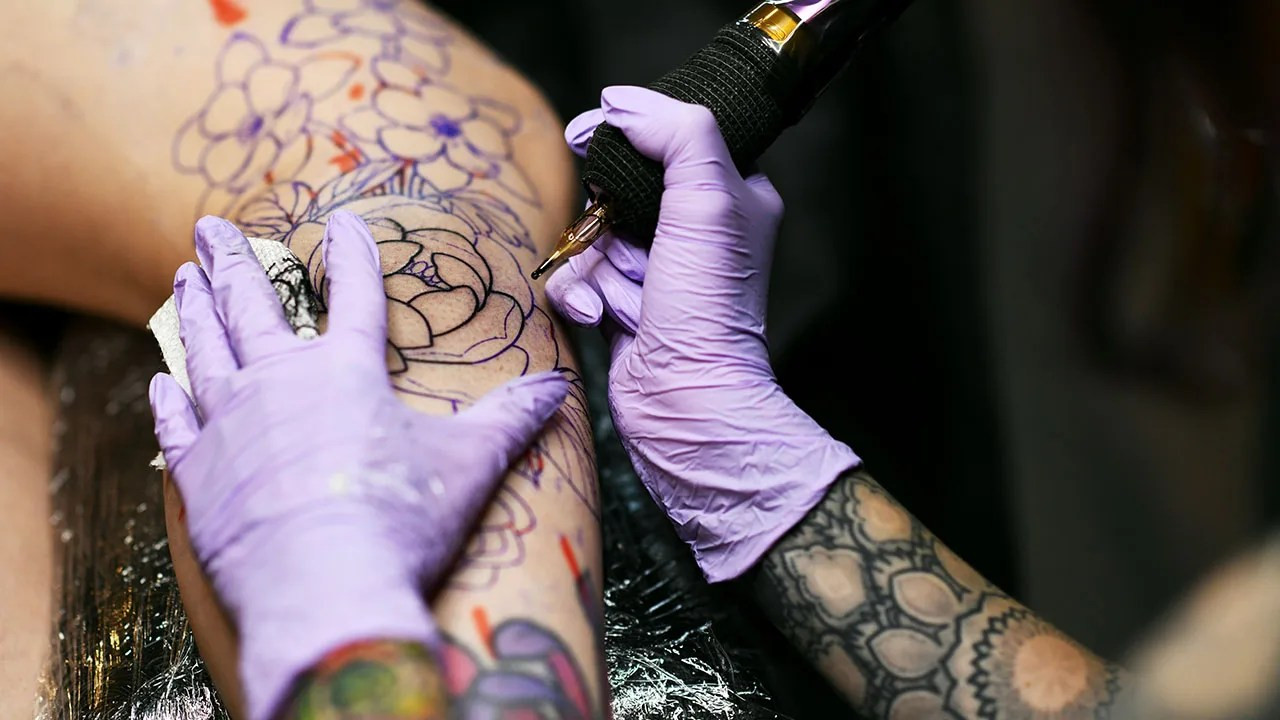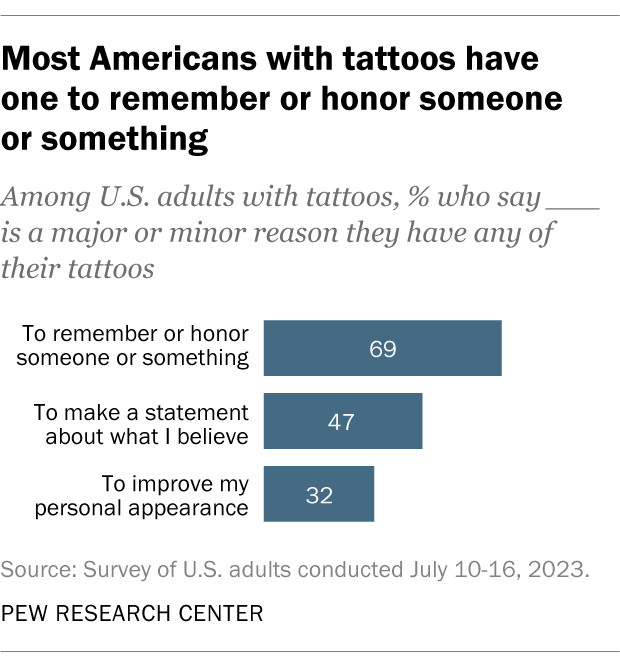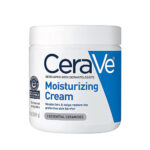Do More Women Have Tattoos Than Men? Yes, according to a recent Pew Research Center survey, 38% of women have at least one tattoo, compared to 27% of men. At tattooat.com, we delve into the fascinating world of body art, exploring tattoo trends, gender differences, and helping you discover the perfect design and artist to express your unique story. Discover the art, stories, and trends shaping tattoo culture today, including insights into body modification, tattoo designs, and the social perceptions surrounding tattoos.
1. Tattoo Prevalence: Who’s Getting Inked?
Who is most likely to get a tattoo? The prevalence of tattoos varies significantly across different demographics. Here’s a detailed look at the trends:
- Gender: Women are more likely than men to have tattoos. According to research, 38% of women have at least one tattoo, compared to 27% of men. This difference is even more pronounced among younger adults.
- Race and Ethnicity: Black and Hispanic Americans are more likely to have tattoos compared to White and Asian Americans. Specifically, 39% of Black Americans and 35% of Hispanic Americans have tattoos, compared to 32% of White Americans and 14% of Asian Americans.
- Age: Younger adults are significantly more likely to have tattoos. 41% of those under 30 and 46% of those ages 30 to 49 have at least one tattoo, compared to 25% of those ages 50 to 64 and 13% of those 65 and older.
- Education: Individuals with some college education or less are more likely to have tattoos. 37% of those with some college or less have a tattoo, compared to 24% of those with a bachelor’s degree and 21% of those with a postgraduate degree.
- Income: Lower-income adults are more likely to have tattoos. 43% of lower-income adults have a tattoo, compared to 31% of those in middle-income households and 21% of those in upper-income households.
- Religion: Those who are religiously unaffiliated are more likely to have tattoos. 41% of religiously unaffiliated adults have at least one tattoo, compared to 29% of those who are affiliated with a religion.
- Sexual Orientation: Lesbian, gay, or bisexual Americans are more likely to have tattoos. Around half (51%) have at least one tattoo, with a particularly high share among women in this group (68%).
 A tattoo artist carefully inks a design onto a client's arm in a studio setting, showcasing precision and artistry
A tattoo artist carefully inks a design onto a client's arm in a studio setting, showcasing precision and artistry
2. Why Are Women Getting More Tattoos?
What factors contribute to the higher prevalence of tattoos among women? Several social and cultural factors may explain why women are more likely to get tattoos than men:
- Increased Self-Expression: Tattoos have become a powerful form of self-expression, allowing individuals to showcase their personality, beliefs, and experiences. Women, in particular, may use tattoos as a way to reclaim their bodies and express their individuality.
- Changing Social Norms: As societal acceptance of tattoos grows, more women may feel comfortable getting inked without fear of judgment or stigma. The normalization of tattoos in popular culture and media has also played a significant role.
- Emotional and Sentimental Reasons: Women are more likely to get tattoos to honor or remember someone or something important to them. Tattoos can serve as a lasting tribute to loved ones, significant events, or personal milestones.
- Aesthetic Appeal: Many women view tattoos as a form of body art and a way to enhance their appearance. Tattoos can be seen as a fashionable accessory, adding a unique and personal touch to their style.
- Empowerment: Getting a tattoo can be an empowering experience, allowing women to take control of their bodies and make a statement about their identity. Tattoos can be a symbol of strength, resilience, and self-love.
3. Tattoo Designs: What Are Women Choosing?
What tattoo designs are popular among women? The choice of tattoo designs often reflects personal preferences, cultural influences, and current trends. Here are some popular tattoo themes among women:
- Floral Designs: Flowers are a classic and timeless choice for women’s tattoos. They can symbolize beauty, love, growth, and resilience. Popular floral designs include roses, lilies, lotus flowers, and cherry blossoms.
- Animal Tattoos: Animal tattoos can represent various qualities and characteristics. Common choices include butterflies (transformation), birds (freedom), wolves (loyalty), and cats (independence).
- Quotes and Script: Meaningful quotes, song lyrics, or personal mantras are often chosen by women for their tattoos. These can serve as daily reminders or expressions of their beliefs.
- Geometric Patterns: Geometric designs are a modern and stylish option. They can be simple or intricate, representing harmony, balance, and interconnectedness.
- Minimalist Tattoos: Small, delicate tattoos are gaining popularity. These can be simple shapes, symbols, or initials, often placed in discreet locations.
 A person displays a delicate floral tattoo on their shoulder, highlighting the beauty and intricacy of the design
A person displays a delicate floral tattoo on their shoulder, highlighting the beauty and intricacy of the design
4. Finding the Perfect Tattoo Artist at Tattooat.com
How can tattooat.com help you find the ideal tattoo artist? Finding a skilled and reputable tattoo artist is crucial to ensure a safe and satisfying experience. At tattooat.com, we provide a platform to connect you with talented artists who specialize in various styles and techniques. Here’s how we can assist you:
- Extensive Artist Directory: Our website features a comprehensive directory of tattoo artists, complete with portfolios, reviews, and contact information. You can easily browse through different artists and find one whose style aligns with your vision.
- Specialization Filters: You can filter artists based on their specialization, such as realism, traditional, watercolor, or geometric. This allows you to narrow down your search and find an artist who excels in the specific style you desire.
- Location-Based Search: Our location-based search feature helps you find artists in your area. Simply enter your city or zip code, and we’ll show you a list of nearby tattoo studios and artists.
- Portfolio Reviews: Each artist profile includes a portfolio of their work, allowing you to assess their skills and creativity. You can also read reviews from previous clients to get an idea of their professionalism and customer service.
- Direct Contact: You can contact artists directly through our platform to discuss your tattoo ideas, ask questions, and schedule a consultation.
5. Tattoo Aftercare: Ensuring a Beautiful and Lasting Tattoo
How do you properly care for a new tattoo? Proper aftercare is essential to ensure that your tattoo heals correctly and remains vibrant for years to come. Here are some essential aftercare tips:
- Keep it Clean: Gently wash your tattoo with mild, fragrance-free soap and warm water 2-3 times a day. Avoid using harsh chemicals or abrasive scrubs.
- Moisturize: Apply a thin layer of fragrance-free moisturizer to your tattoo after each wash. This will help keep the skin hydrated and prevent scabbing.
- Avoid Sun Exposure: Protect your tattoo from direct sunlight by wearing loose-fitting clothing or applying a high-SPF sunscreen. Sun exposure can cause the tattoo to fade over time.
- Don’t Pick or Scratch: Resist the urge to pick or scratch your tattoo, as this can damage the skin and lead to infection.
- Stay Hydrated: Drink plenty of water to keep your skin hydrated from the inside out.
- Avoid Soaking: Avoid swimming, hot tubs, and long baths until your tattoo is fully healed. Soaking can increase the risk of infection.
- Follow Artist’s Instructions: Always follow the specific aftercare instructions provided by your tattoo artist. They may have additional recommendations based on your skin type and the tattoo design.
6. Tattoo Regret: What to Do If You Change Your Mind
What are your options if you regret a tattoo? While most people love their tattoos, some may experience regret later in life. If you find yourself unhappy with a tattoo, here are some options to consider:
- Laser Tattoo Removal: Laser tattoo removal is the most effective method for removing unwanted tattoos. It involves using laser energy to break down the tattoo ink into smaller particles, which are then naturally eliminated by the body. Multiple sessions are typically required.
- Tattoo Cover-Up: A cover-up tattoo involves creating a new design that incorporates or completely conceals the old tattoo. This option is best suited for tattoos that are relatively small and light in color.
- Fading Creams: Tattoo fading creams are available over-the-counter, but their effectiveness is limited. These creams may help to lighten the tattoo, but they are unlikely to remove it completely.
- Acceptance: Sometimes, the best approach is to accept the tattoo and learn to live with it. Over time, you may find that the tattoo becomes a part of your personal history and identity.
7. The Growing Acceptance of Tattoos in American Society
How has the perception of tattoos changed over time? Tattoos have come a long way from being associated with fringe groups and rebellious subcultures. Today, they are widely accepted and celebrated as a form of art and self-expression. According to a recent Pew Research Center survey, a large majority of U.S. adults say society has become more accepting of people with tattoos in recent decades. Here are some factors contributing to this shift:
- Increased Visibility: Tattoos are now more visible than ever, thanks to their prevalence in popular culture, media, and everyday life. As more people get tattoos, they become more normalized and less stigmatized.
- Artistic Recognition: Tattoos are increasingly recognized as a legitimate art form, with talented artists pushing the boundaries of creativity and innovation. Tattoo conventions and art galleries showcase the beauty and skill of tattoo art.
- Personal Expression: Tattoos are seen as a way to express individuality and personal stories. People get tattoos to commemorate important events, honor loved ones, or showcase their beliefs and passions.
- Changing Workplace Attitudes: Many workplaces have become more accepting of tattoos, allowing employees to display their ink without fear of discrimination. This shift reflects a broader trend towards greater diversity and inclusion in the workplace.
- Celebrity Influence: Celebrities with tattoos have played a significant role in popularizing and normalizing body art. Their tattoos inspire fans and help to break down stereotypes.
 A person showcasing a vibrant and intricate full-sleeve tattoo, highlighting the artistry and personal expression involved
A person showcasing a vibrant and intricate full-sleeve tattoo, highlighting the artistry and personal expression involved
8. Tattoos and Body Image: A Form of Empowerment
How can tattoos contribute to body positivity and self-esteem? Tattoos can be a powerful tool for reclaiming one’s body and enhancing self-esteem. Here are some ways tattoos can promote body positivity:
- Reclaiming Control: Getting a tattoo allows individuals to take control of their bodies and make a personal statement about their identity. This can be especially empowering for those who have experienced trauma or body image issues.
- Celebrating Scars: Tattoos can be used to cover or enhance scars, turning them into works of art. This can help individuals to embrace their scars and see them as symbols of strength and resilience.
- Enhancing Body Confidence: Tattoos can accentuate certain features or create the illusion of curves, helping individuals to feel more confident and comfortable in their own skin.
- Expressing Individuality: Tattoos allow individuals to express their unique personality and style, setting them apart from the crowd. This can boost self-esteem and promote a sense of authenticity.
- Creating a Positive Narrative: Tattoos can tell a story or convey a message that is meaningful to the individual. This can help them to create a positive narrative about themselves and their lives.
9. Trends in Tattoo Culture: What’s New and Exciting?
What are the latest trends in tattoo culture? Tattoo culture is constantly evolving, with new styles, techniques, and trends emerging all the time. Here are some of the hottest trends in tattoo culture right now:
- Fine Line Tattoos: These delicate and intricate tattoos feature thin, precise lines and minimalist designs. They are often placed in discreet locations and are popular among those seeking a subtle and elegant look.
- Watercolor Tattoos: These vibrant and artistic tattoos mimic the look of watercolor paintings, with soft, flowing colors and blurred edges. They are often used to create beautiful and ethereal designs.
- Geometric Tattoos: These modern and stylish tattoos feature geometric shapes, patterns, and lines. They can be simple or complex, representing harmony, balance, and interconnectedness.
- Blackout Tattoos: These bold and dramatic tattoos involve covering large areas of the body with solid black ink. They are often used to conceal unwanted tattoos or scars, or to make a bold statement.
- UV Tattoos: These unique and eye-catching tattoos are made with special ink that glows under ultraviolet (UV) light. They are perfect for those who want a tattoo that is both subtle and attention-grabbing.
10. Navigating Tattoo Studios Safely and Responsibly
How can you ensure a safe and responsible tattoo experience? Choosing a reputable tattoo studio and following safety precautions are essential to ensure a positive and healthy experience. Here are some tips for navigating tattoo studios safely and responsibly:
- Research Studios: Read online reviews, check portfolios, and visit studios in person to assess their cleanliness and professionalism.
- Check Licensing: Ensure that the studio and artists are licensed and certified by the local health department.
- Sterilization: Verify that the studio uses sterilized equipment and disposable needles. The artist should open the needle package in front of you.
- Ask Questions: Don’t hesitate to ask questions about the studio’s safety practices, the artist’s experience, and the aftercare instructions.
- Communicate: Clearly communicate your tattoo ideas and concerns to the artist. Make sure you are both on the same page before starting the tattoo.
- Follow Aftercare: Follow the artist’s aftercare instructions carefully to ensure proper healing and prevent infection.
- Be Aware: Be aware of the risks associated with tattoos, such as allergic reactions, infections, and scarring.
- Trust Your Gut: If you feel uncomfortable or unsafe at any point, don’t hesitate to leave and find another studio.
FAQ: Common Questions About Women and Tattoos
Here are some frequently asked questions about women and tattoos:
- Are tattoos more painful for women?
Pain perception varies, but generally, women and men experience tattoo pain similarly. Factors like tattoo placement, size, and individual pain tolerance play significant roles. - Do women’s tattoos fade faster than men’s?
Tattoo fading depends on factors like sun exposure, skin hydration, and aftercare, not gender. Proper care is essential for maintaining tattoo vibrancy. - What tattoo locations are most popular among women?
Popular locations include the upper back, shoulder, ankle, wrist, and rib cage, often chosen for aesthetic appeal and ease of concealment. - Are there specific tattoo styles that are more popular among women?
Floral designs, fine line tattoos, and watercolor styles are commonly favored by women, though personal preferences vary widely. - How do tattoos affect women’s careers?
Workplace acceptance of tattoos is increasing, but some professions still have restrictions. Consider visibility and potential impact on career goals. - Do tattoos affect pregnancy?
Tattoos themselves don’t directly affect pregnancy, but stretching skin can alter tattoo appearance. Consult a doctor about any concerns. - What should women consider when choosing a tattoo artist?
Look for artists specializing in the desired style, review portfolios, and ensure they follow strict sterilization practices. - How can women ensure their tattoos age well?
Protect tattoos from sun exposure, keep skin hydrated, and follow proper aftercare instructions to maintain vibrancy. - Are there any health risks specific to women with tattoos?
No, health risks are generally the same for both genders. Ensure the studio follows proper sanitation protocols to minimize risks. - How has social media influenced women’s tattoo choices?
Social media platforms like Instagram and Pinterest inspire tattoo designs and connect women with artists, influencing trends and choices.
Tattoos offer a canvas for self-expression, and tattooat.com is your guide to exploring this vibrant world. Whether you’re seeking inspiration, searching for a skilled artist, or need expert advice on aftercare, we’re here to support your tattoo journey.
Ready to start your tattoo adventure? Visit tattooat.com today to discover stunning designs, connect with talented artists, and learn everything you need to know about tattoos in America. Don’t wait—express yourself and find the perfect tattoo that tells your unique story.
Address: 1825 SW Broadway, Portland, OR 97201, United States.
Phone: +1 (503) 725-3000.
Website: tattooat.com.

